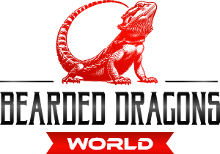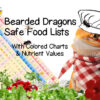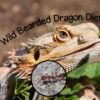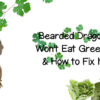In the diverse and arid environments of Australia, bearded dragons exhibit a remarkable adaptability in their diet. Studies on the wild bearded dragon diet shows they are opportunistic foragers of vegetation and arthropods.
The diet of wild bearded dragons is dynamic and can shift with age, geography, and availability of food resources. Younger bearded dragons lean towards a insectivorous diet, feasting on a selection of insects and arthropods. Adults transition to being more omnivorous, incorporating plant matter into their diets.

Jump To…
Key Takeaways
- Bearded dragons adjust their diet based on age and food availability in the wild.
- They are predominantly insectivores as juveniles and become more omnivorous as adults.
- The natural diet of wild bearded dragons guides dietary best practices for those in captivity.
Dietary Transitions of the Eastern Bearded Dragon
Juvenile Wild Bearded Dragon Diet: The Insectivorous Beginnings
The life of a juvenile bearded dragon is marked by an insatiable pursuit of insects. In this phase, the wild bearded dragon diet is overwhelmingly insectivorous, teeming with a variety of agile arthropods such as beetles, grasshoppers and spiders. Their choice of invertebrate included much more active species than adults including.
Wotherspoon and Shelley (2016) found that juvenile bearded dragons ate active prey including flying invertebrates. Juveniles require a high protein diet that supports growth.
This high-protein regimen is crucial for their swift growth during these formative years. As active hunters, juvenile bearded dragons expertly navigate their surroundings, honing in on the protein-rich arthropods essential for their development.
Wotherspoon (2007) found that the wild bearded dragon diet for juveniles included plant content only after reaching a snout to vent size of 80-100 mm (3-4 inches).
Adult Wild Bearded Dragon Diet: Role of Gender and Size
With maturity comes a significant dietary shift for the Eastern Bearded Dragon. As they transition from the fervent insect hunting of their youth, adults begin to incorporate plant material into their diet, marking the onset of omnivory. This dietary expansion reflects a broader adaptation to their evolving physiological and energetic needs, allowing them to thrive in a wider range of environmental niches.
The adult life stage unveils further complexity in the wild bearded dragon diet habits. The Eastern Bearded Dragon shows clear distinctions arising between male to female and among different ages.
Wotherspoon (2007) found the vegetation content in the adult wild bearded dragon diet was so high (90% or more) that it was suspected that the odd insect was consumed (mostly ants) by accident while eating vegetation. In addition, that the invertebrate found most commonly eaten in the adult wild bearded dragon diet were those that are easy to catch such as ants and beetles.
Wotherspoon and Shelley (2016) identified notable differences in the wild bearded dragon diet between male and female bearded dragons, as well as variations based on the size of the males.
Females, burdened with the nutritional demands of egg production, continue to rely more heavily on animal matter heavily featuring ants. This reliance on a protein-rich diet is essential for meeting the heightened nutritional needs associated with reproduction. Females need higher levels of protein and fatty acids than males for reproduction purposes.
Larger males exhibit a pronounced shift towards herbivory, likely influenced by their reduced protein requirements during non-combative territorial displays in the mating season. This herbivorous tendency among larger males contrasts sharply with the dietary preferences of females. Notably, none of the plant material was chewed, suggesting a different consumption method compared to invertebrates.
Juveniles vs. Adults Wild Bearded Dragon Diet
The dietary journey from juvenile to adult in the Eastern Bearded Dragons is characterized by a marked shift in preferences.
Juveniles, with their voracious appetite for active prey like grasshoppers and locusts, embody the quintessential predator, seeking out the high-protein meals vital for their rapid growth.
However, as they age, a gradual inclusion of plant matter signifies their transition towards a more omnivorous diet. This shift is not merely a change in taste but a reflection of the dragon’s adaptive strategies to maximize nutritional intake and energy efficiency as they navigate the challenges of adulthood.
The wild bearded dragon diet transitions from a juvenile insectivore to an omnivorous adult. This shift, along with nuanced variations influenced by gender and size, illustrates the complex interplay between biology, ecology, and behavior in these remarkable reptiles.
Wild Bearded Dragon Diet: Stomach Contents
Oonincx et al (2015) studied the stomach content of 10 adult bearded dragons (Pogona vitticeps). Their research found that just over 60% was made up of invertebrates with 95% of that being termites. Invertebrates that made up the remainder included spider, locust, centipede, dragonfly and mosquitos.
Interestingly the research by Oonincx et al (2015) also showed a very small portion, 2.3%, of indigestible material in the stomach. The indigestible material included plastic, grit and degraded bone. The study proposed that the degraded bone could potentially be an aid for how bearded dragons get calcium in the wild.
Thompson and Thompsons (2003) studied the Pogona minor. In their research they noted that some of the bearded dragons were moving between bull ant mounds and one was found with a mouth full of bull ants it was eating. Their study did not delve further into the stomach content.
Pianka (2005) published observations of Pogona minor (Dwarf Bearded Dragons) that he collected over a period of almost 40 years. His observations of what the Dwarf Bearded Dragon eats in the wild included grasshoppers, beetles, termites, insect larvae, ants, wasps, phasmids and other bugs. Grasshoppers made up the majority of the diet at 30%, beetles 17% of the diet and termites almost 12% of the diet.
Plant matter of the Dwarf Bearded Dragon was as low as 21% of the diet being a mix of grass, seeds, bark, flowers and other plant material that was not identified.
Rose (cited in Wotherspoon 2007) went through the stomach content of 5 wild Pogona barbata killed on the roads. The wild bearded dragon diet was found to include a range of cockroaches, grasshoppers, locusts, weevils, ants, bull ants (Myrmecia gulosa and Myrmecia tarsata), katydids, matchstick grasshoppers, dung beetles, Christmas beetles and bees. The vegetation was not described.
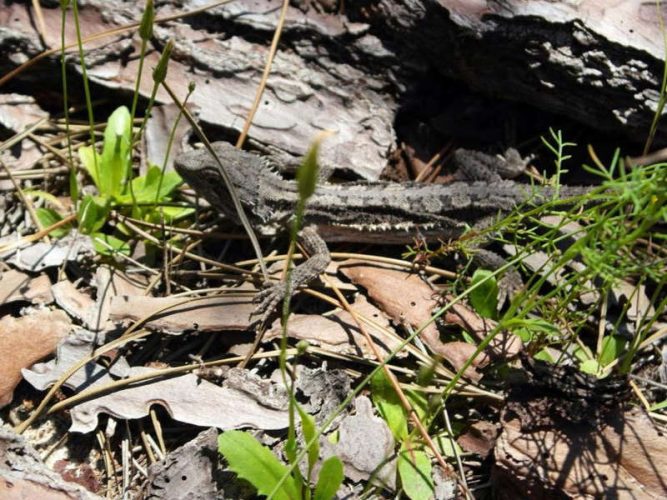
Wotherspoon (2007) studied the stomach contents of 89 free ranging wild bearded dragons (Pogona barbata). The bearded dragons were found to eat a range of invertebrate. The invertebrate ranged from 50% ants to the rarest of the invertebrates which were centipede, grasshopper, locust and caterpillar (total of 7 in the entire range). Dandelion and clover were the main vegetation both of which are introduced species, not native to Australia. Other vegetation included flowers, Kangaroo grass (Themeda australis), Glycine spp and Xanthosia spp.
Incidentally dandelions are very high in protein. Research by Ghaly et al (2012) found dandelions to contain 4.70% protein. As a comparison, apples had 0.26% and sweet potato 2.57%.
Vegetation & Insects Found in the Wild Bearded Dragon Diet
Herbs, grasses and vegetation in the wild bearded dragon diet in the studies reviewed include:
- Dandelions (introduced species)
- Clover (introduced species)
- Flowers
- Grasses (Kangaroo grass – Themeda australis)
- Glycine spp
- Xanthosia spp
Arthropods including insects eaten in the wild bearded dragon diet in the studies reviewed include:
- Termites
- Ants
- Dragonflies
- Mosquitoes
- Cockroaches
- Weevils
- Caterpillars
- Locusts
- Grasshoppers
- Katydids
- Matchstick grasshoppers
- Beetles (including dung beetles and christmas beetles)
- Bees
- Wasps
- Spiders
- Centipedes
- Insect larvae
Foods Eaten By Other Omnivorous Lizards in Australia
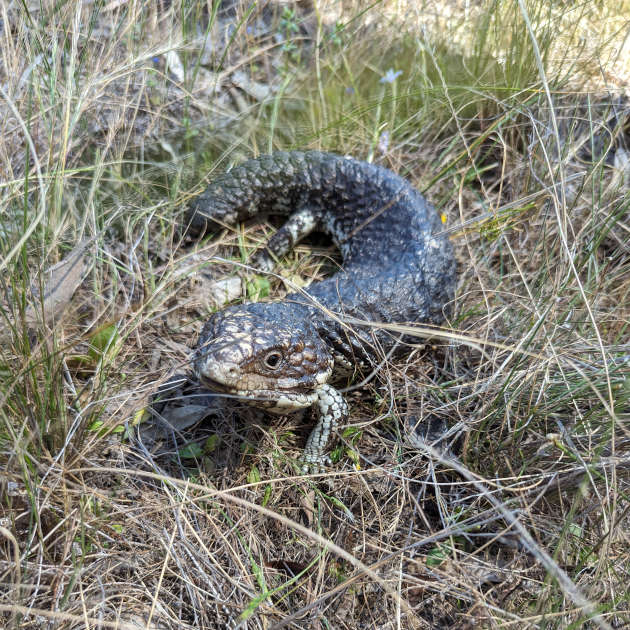
Research on other omnivorous lizard species like the Bluetongue lizards, specifically Tiliqua adelaidensis and Tiliqua rugosa, offers insights into potential safe plant and animal proteins that might be suitable for bearded dragon diets in Australia.
Bluetongue lizards consume a variety of arthropods and plant matter, with their diet changing with the seasons. Studies by Bull et al (2007), Norval et al (2019), and Norval et al (2020) have documented the specific components of their diet as follows:
Arthropods:
- Grasshoppers (particularly from the species Chortoicetes terminifera)
- Ants (likely species of Rhytidoponera and Iridomyrmex)
- Lycosid spiders
- Beetles (order Coleoptera)
- Cockroaches (order Blattodea)
- Winged ants (specifically from a dispersal event)
- White garden snail (Theba pisana)
Plant Matter:
- African Boxthron (Lycium ferocissimum) – fruits/berries
- Berrigan (Eremophila longifolia) – flowers
- Bower spinach (Tetragonia amplexicoma) – fruits/berries
- California Pepper Tree (Schinus molle) – fruits/berries
- Camel bush (Teucrium sessiliflorum) – flowers
- Camel Grass (Angianthus tomentosus) – flowers
- Common Yellow Wood Sorrel (Oxalis corniculata) – leaves
- Dandelion (Artotheca calendula) – flowers, leaves
- False Sowthistle (Reichardia tingitana) – flowers
- Flax Lily (Dianella revoluta) – berries
- Grassy Bindweed (Convolvulus remotus) – flowers and leaves
- Little Bur Clover (Medicago minima) – flowers and leaves
- Medick or burclover (Medicago sp.) – Leaves
- Nitre Bush or Dillon Bush (Nitraria billardieri) – berries
- Paterson’s Curse (Echium plantagineum) – leaves
- Saltbush – Ruby Saltbush or Barrier Saltbush (Enchylaena tomentosa) – fruits/berries
- Saltbush – Berry Saltush (Rhagodia baccata) – berries
- Scrambled eggs, mother ducks, cut-leaved goodenia (Goodenia pinnatifida) – flowers, leaves
- Sea Rocket (Cakile maritima) – flowers, leaves
- Sea Spurge (Euphorbia paralias) – flowers
- Spiny Starwort or Spiny Golden Star (Pallensis spinosa) – flowers
- Stemless Thistle (Onopordum acaulon) – leaves
- Sugarwood (Myoporum platycarpum) – flowers
- Tangled Sida (Sida intricata) – leaves
- Tar Bush (Eremophila glabra) – flowers
- Thread Iris (Moraea setifolia) – leaves
- Ward’s Weed (Carrichtera annua) – flowers, leaves, and pods
- Wild Oat (Avena fatua) -leaves
- Wild Sage (Salvia verbenaca)
- Wooly New Holland Daisy (Vittadinia gracilis) – leaves
- Western Grey Kangaroo (Macropus fuliginosus) – carrion
Other foods consumed included:
- Seeds (unspecified species)
- Leaves (unspecified species)
- Stem material (unspecified species)
- Rabbit scats
- Shed reptile skin, likely from their own moultings
- Small stones which may aid in digestion or might be ingested accidentally while capturing prey.
Wild Bearded Dragon Diet Conclusion
The wild bearded dragon diet includes a range of invertebrates and plants. Bearded dragons are essentially insectivores until they reach adulthood at which point they become omnivores. The volume of plant matter eaten by male wild bearded dragons is so significant that they are almost herbivores.
Frequently Asked Questions
What do bearded dragons eat in the wild?
In the wild, bearded dragons are omnivores, meaning they eat a variety of foods including insects, and a variety of plant matter such as leaves, flowers, and fruits.
Do wild bearded dragons chew their food?
Wild bearded dragons do not chew their food. Research by Wotherspoon (2007) revealed that leaves and flowers found in their intestines of Pogona barbata were intact, showing no signs of chewing. However, grass stems were observed to be snipped into smaller lengths of 3-5 mm.
References
- Bull, M., Hutchinson, M., & Fenner, A. (2007). Omnivorous diet of the endangered Pygmy Bluetongue Lizard, Tiliqua adelaidensis. Amphibia-Reptilia, 28(4), 560–565.
- Ghaly, A. E., Mahmoud, N. & Dave, D. (2012). Nutrient Composition of Dandelions and its Potential as Human Food. American Journal of Biochemistry and Biotechnology, 8(2), 118-127.
- Norval, G., Clayton, J., Sharrad, R. D., & Gardner, M. G. (2020). Notes on the stomach contents of a juvenile Sleepy Lizard, Tiliqua rugosa (Gray 1825), killed by an Eastern Brown Snake, Pseudonaja textilis (Duméril, Bibron, and Duméril 1854) in South Australia. Reptiles & Amphibians, 25(3), 200–203.
- Norval, G., Sharrad, R. D., & Gardner, M. G. (2019). Two instances in South Australia of Sleepy Lizards, Tiliqua rugosa (Gray 1825), feeding on plant species not previously recorded as part of this lizard’s diet. Reptiles & Amphibians, 26(1), 54–55.
- Oonincx, D. G. A. B., Leeuwen, J. P. van., Hendriks, W. H., and Poel, A. F. B. van der. (2015) The Diet of Free-Roaming Australian Central Bearded Dragons (Pogona vitticeps). Zoo Biology 3
- Pianka, Eric, R. 2005. The ecology and natural history of the dwarf bearded dragon Pogona minor in the Great Victoria Desert Australia Draco, 6(N): 63-66 Nr 22.
- Thompson, S. A., & Thompson, G. G. (2003) The western bearded dragon, Pogona minor (Squamata: Agamidae): An early lizard coloniser of rehabilitated areas. Journal of the Royal Society of Western Australia, 86, pp 1-6.
- Wotherspoon, D., and Burgin, S. 2011. Allometric variation among juvenile, adult male and female eastern bearded dragons Pogona barbata (Cuvier, 1829), with comments on the behavioural implications. Zoology (Jena, Germany) 114, 23–28.
- Wotherspoon, D., and Burgin, S. 2016. Sex and ontogenetic dietary shift in Pogona barbata, the Australian eastern bearded dragon. Australian Journal of Zoology 64, 14-20.
- Wotherspoon, A. D. (2007). Ecology and management of Eastern bearded dragon : Pogona barbata. Thesis, University of Western Sydney, Richmond. Retrieved from University of Western Sydney Library.

